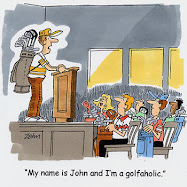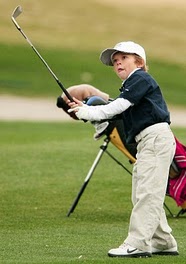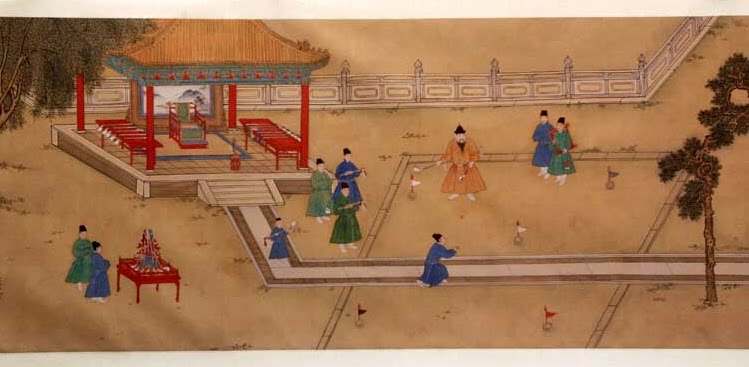Putters are a special class of clubs with a loft not exceeding ten degrees (except chippers), designed primarily to roll the ball along the grass, generally from a point on the putting green towards the cup. Contrary to popular belief, putters do have a loft (often 5 degrees from truly perpendicular at impact) that helps to lift the ball from any indentation it has made. Newer putters also include grooves on the face to promote roll rather than a skid off the impact. This increases rolling distance and reduces bouncing over the turf. Also present in some golfers' bags is the "chipper" which is designed for low-speed swings to lift the ball a short distance about 25 yards/23 meters, onto the green. The club can be used in place of the pitching wedge with an abbreviated swing to accomplish the same end.
Putting is the most precise aspect of the game of golf. The putter must be designed to give the golfer every technical advantage including smooth stroke, good glide, sweet impact, and bounce-less topspin ball launch as well as every technique advantage including perfect fit as to shaft angle and length.
Putters usually have a loft of 5° but cannot be more than 10°. The putter is the only club that may have a grip that is not perfectly round; "shield"-like cross-sections with a flat top and curved underside are most common. The putter is also the only club allowed to have a bent shaft; often, clubmakers will attach the shaft to the clubhead on the near edge for visibility, but to increase stability, the shaft is bent near the clubhead mounting so that its lie and the resulting clubhead position places the line of the straight part of the shaft at the sweet spot, where the ball should be for the best putt. This increases accuracy as the golfer can direct their swing through the ball, without feeling like they are slightly behind it.
The design of the putter's clubhead has undergone radical change in the last 20–30 years, as have many club types. The putter was originally a forged iron piece very similar in shape to the irons of the day. Through attempts to lower the center of gravity of the clubhead, it evolved into a shorter, thicker head slightly curved from front to rear (the so-called "hot dog" putter). The introduction of investment casting for club heads allowed drastically different shapes to be made far more easily and cheaply than with forging, resulting in several design improvements. First of all, the majority of mass behind the clubface was placed as low as possible, resulting in an L-shaped side profile with a thin, flat clubface and another thin block along the bottom of the club behind the face. Additionally, peripheral weighting, or the placing of mass as far away from the center of the clubface as possible, increases the moment of inertia of the clubhead, reducing twisting if the club contacts the ball slightly off-center and thus giving the club a larger "sweet spot" with which to contact the ball. Newer innovations include replacing the metal at the "sweet spot" with a softer polymer compound that will give and rebound at impact, which increases the peak impulse (force per millisecond) imparted to the ball for better distance. Putters are subdivided into mallet, peripheral weighted and blade styles. Power adjustability and practice/play convertibility are features embodied in the latest putter design technology.
For New Golfers
Monday, March 22, 2010
Monday, March 15, 2010
Learn about Wood
A wood is a type of club used in the sport of golf. Woods are used to hit the ball farther (greater distances) than any other type of golf club.
Woods are so called because, traditionally, they had a club head that was made from hardwood, generally persimmon[1] but modern clubs have heads made from metal, for example titanium, or composite materials, such as carbon fiber. Some golf enthusiasts refer to these as "metals" or "metal woods" but this change in terminology is not strictly necessary, because while the material has changed, the style and intended use has not. The change to stronger materials has allowed the design of the modern woods to incorporate significantly larger heads than in the past. Because of the increase in club head size, in 2004 the USGA created a new stipulation for the size of the club head. The legal maximum (by the rules of golf) of a wood is 460 cubic centimeters[2].
Woods are numbered in ascending order with the driver, or 1-wood, which is designed to hit the ball the greatest distance, having the longest length and lowest loft, typically between 7 and 13 degrees. However there is no industry standard and some overlap occurs. With the typical loft of a 2-wood being 12-13o a 1-wood and 2-wood could have the same loft. Other differences in club design, such as head size, face roll, weight distribution, lie angle, or club length, could also differentiate a 12o 1-wood intended for tee shots and a 12o 2-wood intended for fairway shots. Most club manufacturers’ matched sets include 1-3-5 numbered wood. Even numbers are less common with modern clubs. The number of the club is mainly a reference for the player to easily identify the clubs. Other identifiers have been utilized such as strong and plus to differentiate various lofts within a line of clubs.
Woods generally fall into two classes, drivers and fairway woods, with a traditional set of 14 clubs comprising a driver, two fairway woods (3 and 5), ten irons and a putter[2]. Many modern sets tend to include hybrid clubs, which combine some of the characteristics of a wood and an iron, to replace the 5 wood and longer (3 and 4) irons.
There was a time when woods were made out of...wood. In fact, these were the clubs of choice during the feathery-ball era, which lasted from the 15th Century to the middle of the 19th Century. With the introduction of the Taylor Made Pittsburgh Persimmon metal-headed driver in 1979, golf club design changed again. Although this club wasn't immediately embraced by purists because of its sound at impact and nontraditional appearance, it nonetheless allowed club designers greater latitude.
With metal (usually steel), the designer can easily make the clubhead larger or smaller, add runners to the sole, or build out the toe--all in an effort to make the club perform better. In other words, to help you hit the ball straighter and with more confidence. Steel also has a higher strength-to-weight ratio than wood, allowing the club maker to use less material without sacrificing strength. The result is a lighter, easier-to-swing clubhead. Also, to help the club perform better and be more forgiving, weight is moved to the perimeter of the clubhead to help it square at impact and be more stable on off-center hits.
adapted from learnaboutgolf.com and wikipedia
Woods are so called because, traditionally, they had a club head that was made from hardwood, generally persimmon[1] but modern clubs have heads made from metal, for example titanium, or composite materials, such as carbon fiber. Some golf enthusiasts refer to these as "metals" or "metal woods" but this change in terminology is not strictly necessary, because while the material has changed, the style and intended use has not. The change to stronger materials has allowed the design of the modern woods to incorporate significantly larger heads than in the past. Because of the increase in club head size, in 2004 the USGA created a new stipulation for the size of the club head. The legal maximum (by the rules of golf) of a wood is 460 cubic centimeters[2].
Woods are numbered in ascending order with the driver, or 1-wood, which is designed to hit the ball the greatest distance, having the longest length and lowest loft, typically between 7 and 13 degrees. However there is no industry standard and some overlap occurs. With the typical loft of a 2-wood being 12-13o a 1-wood and 2-wood could have the same loft. Other differences in club design, such as head size, face roll, weight distribution, lie angle, or club length, could also differentiate a 12o 1-wood intended for tee shots and a 12o 2-wood intended for fairway shots. Most club manufacturers’ matched sets include 1-3-5 numbered wood. Even numbers are less common with modern clubs. The number of the club is mainly a reference for the player to easily identify the clubs. Other identifiers have been utilized such as strong and plus to differentiate various lofts within a line of clubs.
Woods generally fall into two classes, drivers and fairway woods, with a traditional set of 14 clubs comprising a driver, two fairway woods (3 and 5), ten irons and a putter[2]. Many modern sets tend to include hybrid clubs, which combine some of the characteristics of a wood and an iron, to replace the 5 wood and longer (3 and 4) irons.
There was a time when woods were made out of...wood. In fact, these were the clubs of choice during the feathery-ball era, which lasted from the 15th Century to the middle of the 19th Century. With the introduction of the Taylor Made Pittsburgh Persimmon metal-headed driver in 1979, golf club design changed again. Although this club wasn't immediately embraced by purists because of its sound at impact and nontraditional appearance, it nonetheless allowed club designers greater latitude.
With metal (usually steel), the designer can easily make the clubhead larger or smaller, add runners to the sole, or build out the toe--all in an effort to make the club perform better. In other words, to help you hit the ball straighter and with more confidence. Steel also has a higher strength-to-weight ratio than wood, allowing the club maker to use less material without sacrificing strength. The result is a lighter, easier-to-swing clubhead. Also, to help the club perform better and be more forgiving, weight is moved to the perimeter of the clubhead to help it square at impact and be more stable on off-center hits.
adapted from learnaboutgolf.com and wikipedia
Labels:
Learn About Wood
Friday, March 12, 2010
Learn about Iron
Wedges are irons with a higher loft than a 9 iron, which is typically lofted at about 42 degrees. Wedges are used for a variety of short-distance, high-altitude, high-accuracy shots such as hitting the ball onto the green ("approach" shots), placing the ball accurately on the fairway for a better shot at the green ("lay-up" shots), or hitting the ball out of hazards or rough onto the green (chipping). There are usually six types of wedges with lofts ranging from 45° to 64°: pitching wedge (PW 48°), gap wedge (GW 52°), sand wedge (SW 56°), lob wedge (LW 60°), and ultra lob wedge (LW 64°)[1]. The pitching wedge is sometimes called or labeled as a 10 iron, and the gap wedge is sometimes called an approach wedge or Utility Wedge and labeled with AW or UW respectively
adapted from wikipedia
Labels:
Learn about Iron
Monday, March 1, 2010
Learn About Hybrid
Hybrids are a cross between a wood and an iron, giving these clubs the wood's long distance with the iron's familiar swing. These clubs generally are used instead of high-numbered woods and/or low-numbered irons, though some manufacturers produce entire sets of hybrids or "iron replacements" that incorporate hybrid design to add distance and forgiveness to a player's entire set of irons from 1 to pitching wedge. Most hybrids take the place of an iron, but the hybrid is easier to hit than its respective iron. These clubs are often referred to as "Rescues" because the TaylorMade Rescue was one of the first clubs to utilize this design, as well as the use of the clubs to get one out of a tricky position (to be in fact rescued by the club).
Features you will find on the hybrid are:
•Flatness of the face on the hybrid wood. Woods have a curve on the face but the hybrids are flat just like an iron.
•Weighting that is distributed throughout the club like an iron or fairway wood. Most woods have the focus of the weight distributed towards the front.
•A wide sole like a fairway wood, with a club length similar to an iron rather than a wood
The main idea behind the hybrid wood is to be interchangeable and utilize the characteristics of both an iron and a wood. The resultant club is typically easier to hit with less effort than a traditional long and lower lofted iron. The term “long iron” normally describes all the clubs from a two iron through five.
There are multiple reasons why many recreational golfers struggle with long iron shots and the goal of the hybrid wood is to make it easier for you. The most common problems are:
•Not being able to make a complete shoulder turn on the backswing.
•Swinging too hard and throwing off tempo.
•Lower lofted clubs are harder to hit.
Adapted from wikipedia and learnaboutgolf.com
Features you will find on the hybrid are:
•Flatness of the face on the hybrid wood. Woods have a curve on the face but the hybrids are flat just like an iron.
•Weighting that is distributed throughout the club like an iron or fairway wood. Most woods have the focus of the weight distributed towards the front.
•A wide sole like a fairway wood, with a club length similar to an iron rather than a wood
The main idea behind the hybrid wood is to be interchangeable and utilize the characteristics of both an iron and a wood. The resultant club is typically easier to hit with less effort than a traditional long and lower lofted iron. The term “long iron” normally describes all the clubs from a two iron through five.
There are multiple reasons why many recreational golfers struggle with long iron shots and the goal of the hybrid wood is to make it easier for you. The most common problems are:
•Not being able to make a complete shoulder turn on the backswing.
•Swinging too hard and throwing off tempo.
•Lower lofted clubs are harder to hit.
Adapted from wikipedia and learnaboutgolf.com
Labels:
Learn about Hybrid
Subscribe to:
Posts (Atom)
Just for laugh

2nd hand Golf Equipment Marketplace
Use the form if you wish to buy or sell 2nd hand golf equipments and stuff. Do not use this form for New golf equipment.
back to top







